

Tesla Patents Next-Gen Electric Car Battery that Gets 400 Miles on a Single Charge. Over the years, one of the biggest obstacles to widespread electric vehicle adoption has been the issue of how far the car can travel on one charge.

Cars that can only travel 100 miles without plugging in might be okay for your commute to and from work, but since charging stations aren’t as easily-accessible as gas stations, longer distances pose a problem. That’s the issue Tesla Motors is trying to solve with an innovative new type of battery it has just filed to patent — a hybrid lithium-ion and metal-air battery pack that could extend the range of the company’s electric vehicles to 400 miles between charges. The hybrid battery will rely on the more expensive, but more durable lithium-ion component for short-term travel, switching only to the metal-air battery for longer trips.
+Tesla Motors Via CleanTechnica Lead image © Boom Boom. Silicon–air battery. Silicon–air batteries are created from oxygen and silicon.
Such batteries would be lightweight, and have a high tolerance for both extremely dry conditions and high humidity and would provide significant savings in cost and weight because the built-in cathode of conventional batteries is not present in silicon–air batteries.[1][2] The experimental cells described in the journal Electrochemistry Communications using a room-temperature ionic liquid as electrolyte produced between 1 and 1.2 volts at a current density of 0.3 millamperes per square centimeter of silicon.[3] Lithium–air battery. IBM creates breathing, high-density, light-weight lithium-air battery.
Aluminium–air battery. Aluminium–air batteries or Al–air batteries produce electricity from the reaction of oxygen in the air with aluminium.
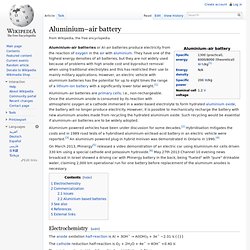
They have one of the highest energy densities of all batteries, but they are not widely used because of problems with high anode cost and byproduct removal when using traditional electrolytes and this has restricted their use to mainly military applications. Aluminium-air battery can power electric vehicles for 1,000 miles, will come to production cars in 2017. Phinergy, an Israeli startup, has demonstrated an aluminium-air battery that is capable of powering an electric vehicle for up to 1,000 miles (1,609km).
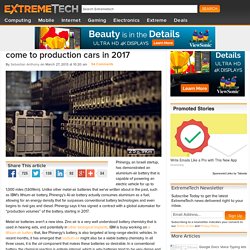
Unlike other metal-air batteries that we’ve written about in the past, such as IBM’s lithium-air battery, Phinergy’s Al-air battery actually consumes aluminium as a fuel, allowing for an energy density that far surpasses conventional battery technologies and even begins to rival gas and diesel. Phinergy says it has signed a contract with a global automaker for “production volumes” of the battery, starting in 2017. Sodium-air battery offers rechargeable advantages compared to Li-air batteries. (Phys.org)—Over the past few years, Li-air batteries (more precisely, Li-oxygen batteries) have become attractive due to their theoretical ability to store nearly as much energy per volume as gasoline.
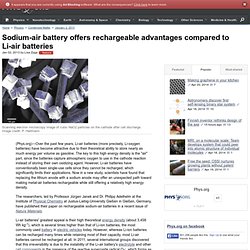
The key to this high energy density is the "air" part, since the batteries capture atmospheric oxygen to use in the cathode reaction instead of storing their own oxidizing agent. However, Li-air batteries have conventionally been single-use cells since they cannot be recharged, which significantly limits their applications.
Now in a new study, scientists have found that replacing the lithium anode with a sodium anode may offer an unexpected path toward making metal-air batteries rechargeable while still offering a relatively high energy density. The researchers, led by Professor Jürgen Janek and Dr. Sodium-air batteries could replace lithium-air as the battery of the future. The world of hardware reshapes itself as fast as it ever has nowadays.
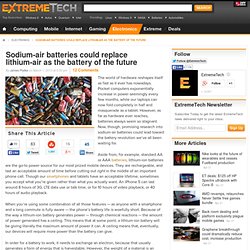
Pocket computers exponentially increase in power seemingly every few months, while our laptops can now fold completely in half and masquerade as a tablet. However, as far as hardware ever reaches, batteries always seem so stagnant. Now, though, promising research into sodium-air batteries could lead toward the battery revolution we’ve all been waiting for. Aside from, for example, standard AA or AAA batteries, lithium-ion batteries are the go-to power source for our most prized mobile devices. They are rechargeable, and last an acceptable amount of time before cutting out right in the middle of an important phone call. When you’re using some combination of all those features — as anyone with a smartphone and a long commute is fully aware — the phone’s battery life is woefully short.
In order for a battery to work, it needs to exchange an electron, because that usually generates a form of energy that is harvestable. Zinc–air battery. Zinc–air hearing aid batteries During discharge, a mass of zinc particles forms a porous anode, which is saturated with an electrolyte.
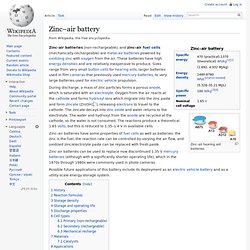
Oxygen from the air reacts at the cathode and forms hydroxyl ions which migrate into the zinc paste and form zincate (Zn(OH)2− 4), releasing electrons to travel to the cathode. The zincate decays into zinc oxide and water returns to the electrolyte. The water and hydroxyl from the anode are recycled at the cathode, so the water is not consumed. The reactions produce a theoretical 1.65 volts, but this is reduced to 1.35–1.4 V in available cells. Zinc–air batteries have some properties of fuel cells as well as batteries: the zinc is the fuel, the reaction rate can be controlled by varying the air flow, and oxidized zinc/electrolyte paste can be replaced with fresh paste.